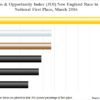Jobs & Opportunity Index: Technical Documentation
[Click here for a printable PDF.]
SOURCES
EQUATION
Each of the three factors is designed to ensure that every component is correctly placed in a numerator (meaning higher is better) or a denominator (meaning lower is better) and to group components so that they properly capture the intended meaning of each factor. Thus:
- The Job Outlook Factor increases when the labor force increases because it is an indicator that people are either working or are reasonably optimistic that they will be able to find work if they look. It decreases when additional people have been unemployed for more than 15 weeks, are “marginally attached” (indicating that they would look for work if they thought they could find it or weren’t prevented from doing so for some other reason), or are working fewer hours than they would like to work. The Center weights this factor at 35% because optimism about job prospects is less important than actually holding a job.
- The Freedom Factor increases when Rhode Islanders find work (even if self-employed or working out of state) and when Rhode Island businesses hire people (even if the employees are from out of state). It decreases with each enrollment in one of three common social welfare programs. An individual could count more than once in both the numerator and the denominator, but the emphasis is relative standing both from state to state and across time.
- The Prosperity Factor increases as the income of Rhode Islanders increases (from various sources) and decreases when taxation increases.
We add the first two factors — the “people factors” — because they are discrete parts of the same basic idea: people finding independence as productive individuals. The components are counts of people in different circumstances. We multiply the combined “people factor” with the “money factor” because the two interact. Income and employment aren’t independent variables, but mutually reinforcing contributors to economic health. Although multiplying the variables in an index can create some degree of distortion as the values change, we mitigate that consideration by normalizing both people and money factors to a 10-point scale.
More important, conceptual manipulation of the equation proved decisively that multiplication produced results that better reflect our values and understanding of healthy economic outcomes. Consider two states, one of which has the best ratio of income to taxes, but the worst score for labor force and employment, earning a 1 out of 10 for the “people factor.” The second state, by contrast, is in the middle of the pack on both counts, with scores of 5 and 5.
Adding the two factors together, the first state would achieve a higher rank than the second, giving preference to states that (to simplify one possibility) have a great deal of wealth floating around, but very few people actually working. If, in theory, state policy makers were to craft policy to gradually move up the index, they might decide to focus on either jobs or income, making a small elite extremely wealthy, for example, and then hope for a trickle-down effect.
Multiplying the factors, by contrast, means that holding the national average for both employment and income is substantially better than leading by one or the other (by a multiple of 2.5 in the example above). Not only does this outcome produce a smoother spectrum for improvement, but it also better reflects our understanding of how economies grow and how they distribute wealth in a way that maximizes the number of people working and encourages productivity and innovation.



